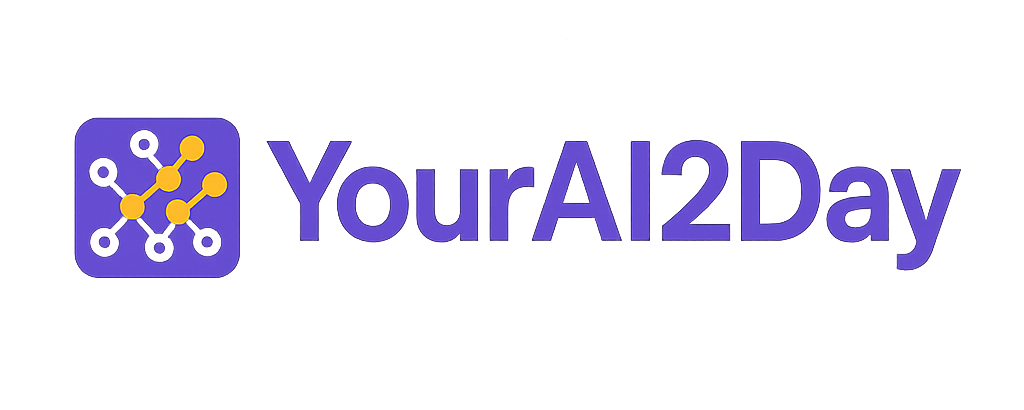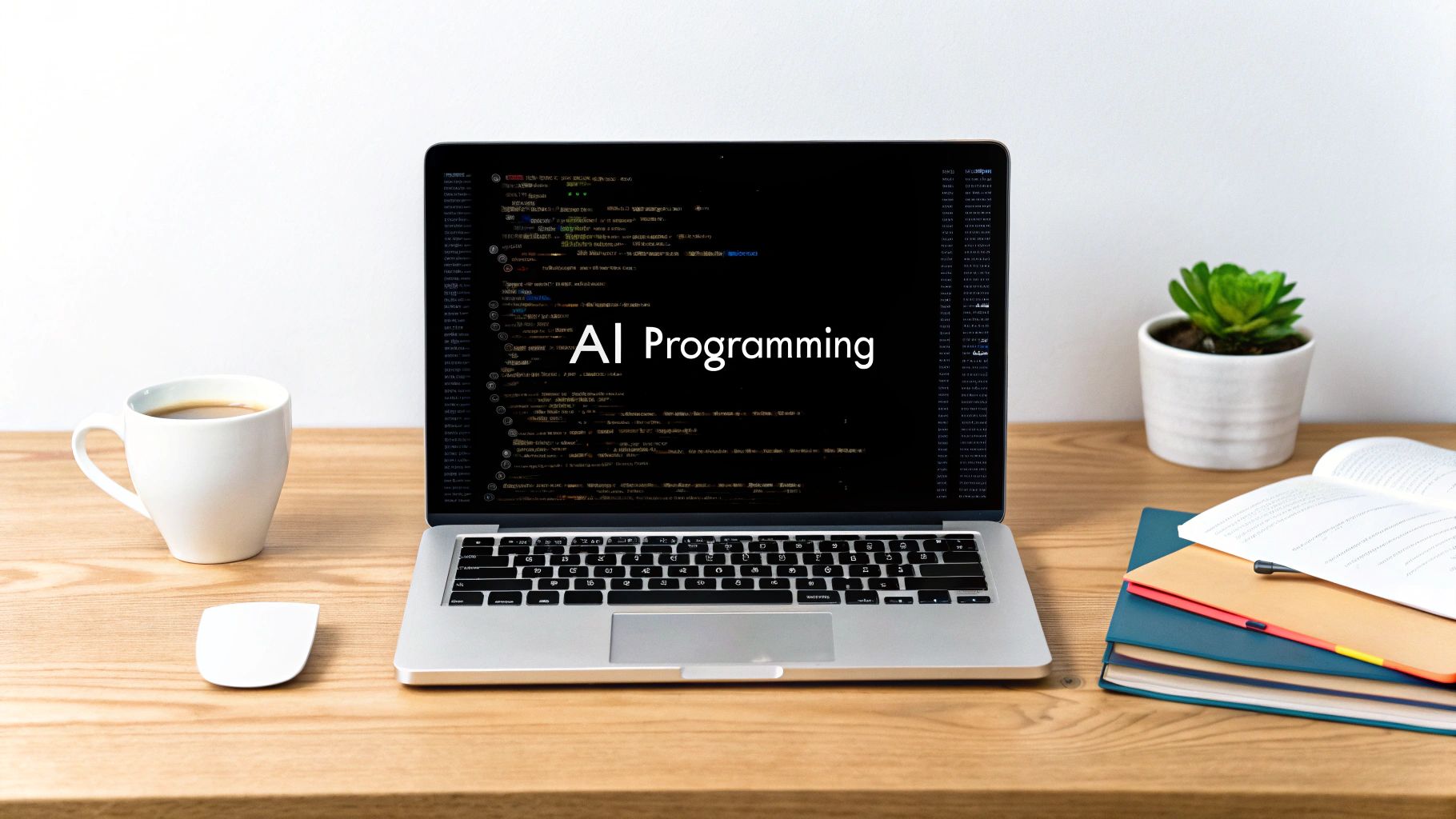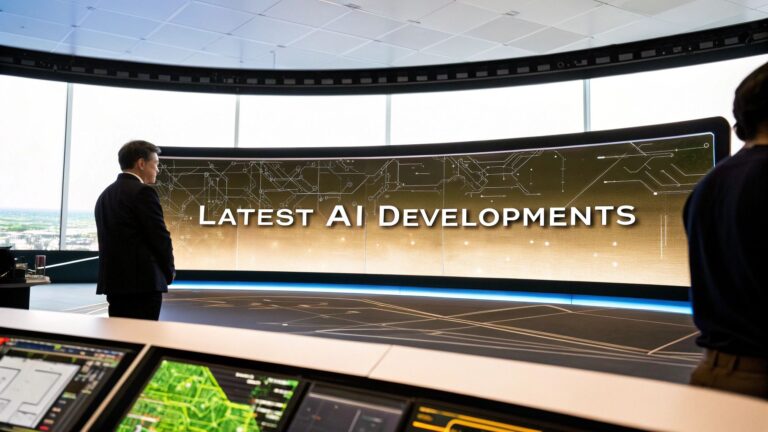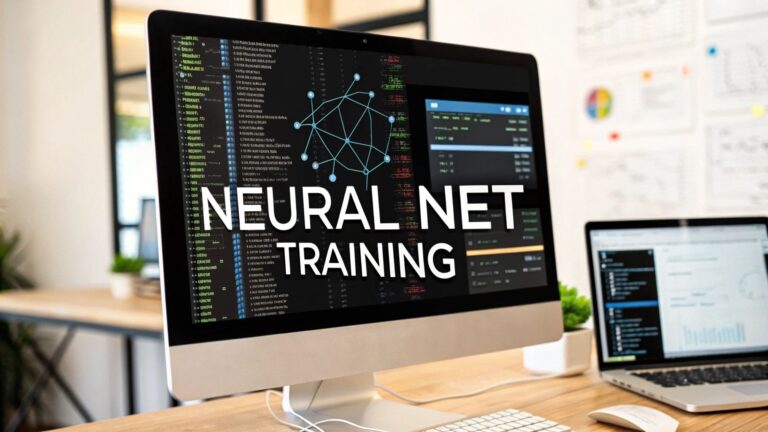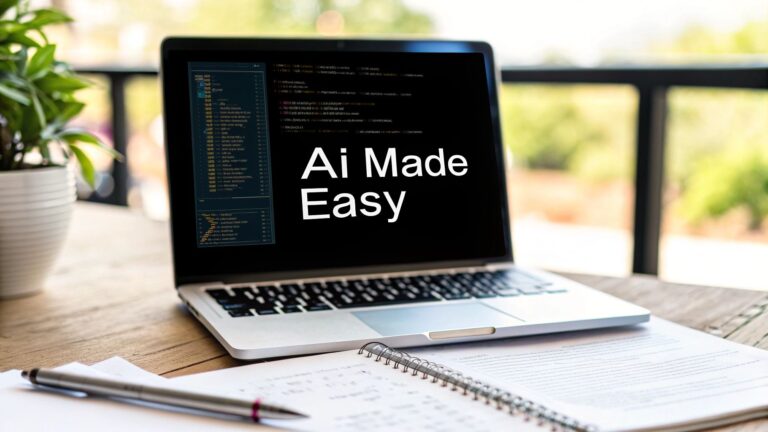How to Program Artificial Intelligence for Beginners
So, you want to program artificial intelligence? It might sound like something out of a sci-fi movie, but at its core, it just means teaching a computer how to spot patterns, make educated guesses, and understand language by feeding it a ton of data. For anyone just starting out, the journey doesn’t begin with building sentient robots. It starts with grasping a few key ideas, picking up a friendly language like Python, and then building small, practical models that actually solve real problems.
Your Starting Point for AI Programming
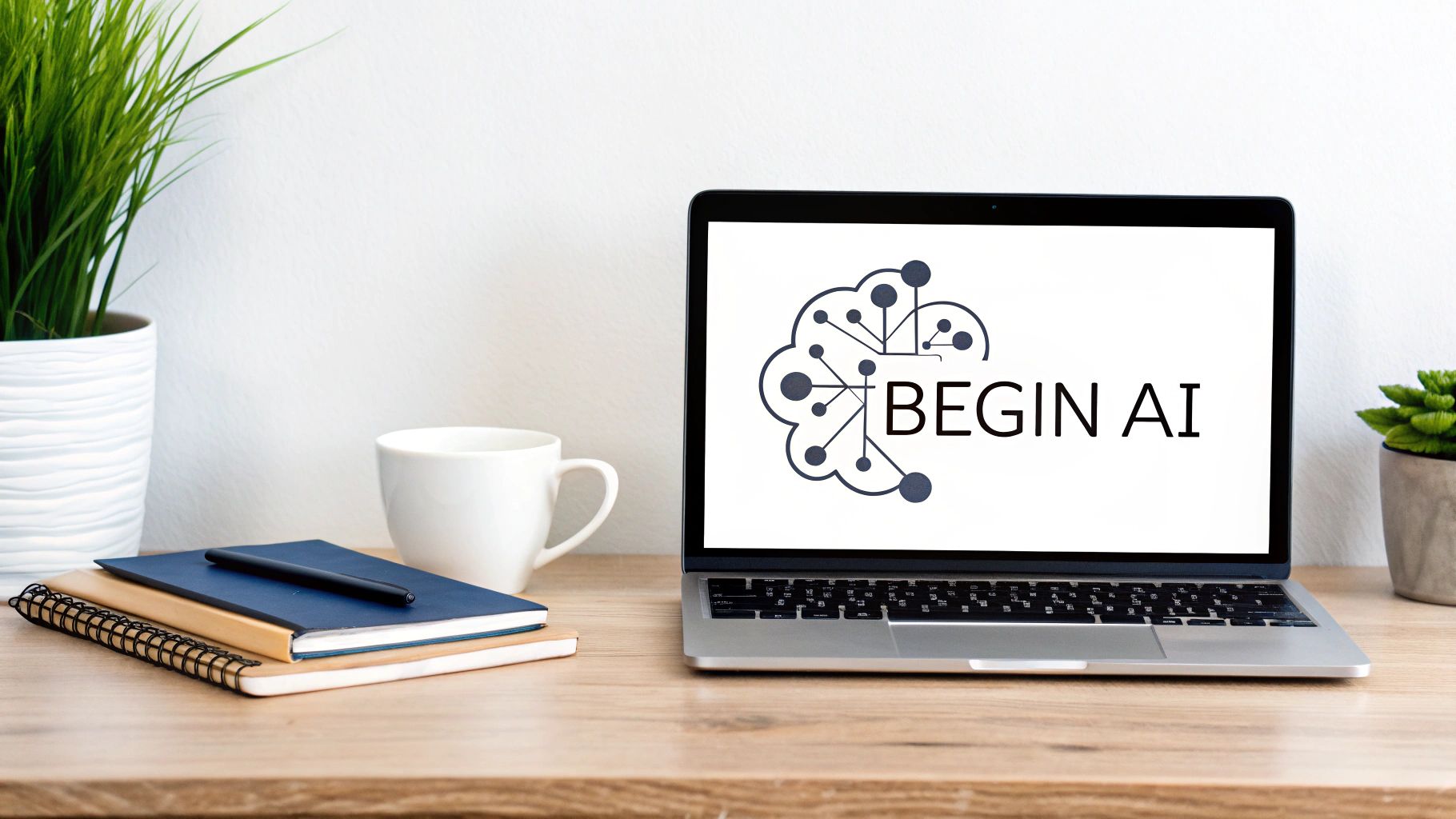
Diving into AI can feel like trying to drink from a firehose. You’re bombarded with terms like "neural networks," "deep learning," and "algorithms," and it's easy to get overwhelmed before you even start. But here’s the secret: you don't need to master everything at once. Your first real step is just getting a clear map of the territory.
Modern AI development is less about inventing complex mathematical formulas from scratch and more about knowing how to wield powerful, pre-built tools to make sense of information. Think of yourself as a chef. You don't need to forge your own knives or grow your own vegetables; you need to know which ingredients and techniques to combine to create an amazing dish.
This practical mindset is essential because the field is exploding. The AI industry isn't just a tech trend; it’s a massive employer. As of 2025, an estimated 97 million people will be working in the AI space, with the global market valued at roughly $391 billion. If you're curious, you can explore more explosive AI industry statistics to get a sense of just how fast things are moving.
Understanding the Core Concepts
Before we even think about writing code, let's nail down the big ideas you'll run into. Getting these fundamentals right gives you a solid foundation and makes all the hands-on stuff feel much more intuitive. These concepts are the bedrock for nearly everything you'll build.
Here's a quick, friendly rundown of the fundamental ideas you'll encounter as you learn to program AI.
| Concept | What It Really Means | A Simple Everyday Example |
|---|---|---|
| Artificial Intelligence (AI) | The big umbrella term for any technique that lets a computer act in a way we'd call "smart." It’s the entire field. | A smart assistant like Siri or Alexa understanding your voice commands. |
| Machine Learning (ML) | A branch of AI where computers learn from data on their own, rather than being explicitly told what to do for every scenario. | Your email spam filter learning to identify junk mail based on messages you've marked as spam in the past. |
| Neural Networks | A specific ML technique inspired by the human brain's structure. It uses layers of interconnected "nodes" to find complex patterns. | The technology that lets your phone’s camera app recognize faces in a photo. |
Getting these distinctions clear is a huge first step. You now have the vocabulary and context to see how all the pieces fit together.
"Your job will not be taken by AI. It will be taken by a person who knows how to use AI. So, it is very important for marketers to know how to use AI." This insight from industry expert Christina Inge hits the nail on the head. AI is a powerful tool, and learning to use it is what creates value—not a fear of being replaced.
With these core ideas in your back pocket, you’re ready to move on. In the next sections, we'll start turning these concepts into real, working code.
Alright, you've got the foundational concepts down. Now comes the fun part: setting up your digital workshop. Just like a good mechanic has a favorite set of wrenches, every AI developer needs a solid lineup of programming languages and software. This isn't about chasing the newest, most complex tools. It's about starting with the industry standards that are powerful but won't leave you stranded.
While you could technically use several languages for AI, one has become the undisputed champion, especially for anyone just getting their feet wet.
Why Python Is the Top Choice for AI
If you walked into a room of ten AI developers and asked what language to learn first, I'd bet good money that at least nine of them would say Python. And for good reason.
Python’s syntax is incredibly clean and readable. It almost feels like writing in plain English, which means you can spend your mental energy grappling with AI concepts instead of fighting with cryptic code.
This isn’t just a matter of opinion; it's about the massive, supportive ecosystem built around it. The AI world is always changing, but Python’s dominance is a constant. As of 2025, it remains the go-to language because its powerhouse libraries—think NumPy, Pandas, PyTorch, and TensorFlow—create a feedback loop that's nearly impossible for other languages to break into. For more on this, check out some insights on top AI programming languages from azumo.com.
Expert Opinion: "Think of Python as the universal language of AI," says Dr. Andrew Ng, a leading figure in the field. "It’s the common ground where researchers, data scientists, and engineers meet. Starting with Python means you're immediately tapping into decades of collective knowledge and tools built by the community."
Your First Python Libraries for AI
Python's real magic for AI isn't just the language itself—it's the libraries. These are massive collections of pre-written code that do the heavy lifting for you. Need to perform some gnarly matrix multiplication? Instead of coding it from scratch, you just call a function from a library.
For anyone starting out, a few libraries are non-negotiable.
Here's a look at the fundamental Python libraries every aspiring AI developer should master first.
Your First Python Libraries for AI
| Library | Its Main Job | Why It's Great for Beginners |
|---|---|---|
| NumPy | Short for "Numerical Python." It’s the engine for all things math, especially handling large arrays and matrices of numbers. | AI is built on a mountain of math. NumPy makes performing complex calculations incredibly fast and surprisingly straightforward. |
| Pandas | Your go-to tool for data wrangling. It lets you load, clean, sort, and explore data from files like CSVs or spreadsheets. | Most AI projects begin with messy, real-world data. Pandas gives you a super-intuitive structure (the DataFrame) to get it all whipped into shape. |
| Scikit-learn | A treasure chest of classic machine learning algorithms. It’s packed with simple, efficient tools for things like prediction and classification. | This library lets you build your first real models without getting bogged down in dense theory. It has dozens of pre-built algorithms ready to go. |
Once you get a handle on these three, you'll have a surprisingly powerful toolkit for a huge range of AI projects. In fact, many of the best AI data analysis tools are built directly on top of this trio, making them a true cornerstone of the modern data science workflow.
Setting Up Your Coding Environment
Last but not least, you need a place to actually write and run your code. While a simple text editor works, the AI community has pretty much standardized on a more interactive style of coding using notebooks.
Notebooks let you write and run your code in small, individual cells, see the output right away, and even mix in notes and images. This is perfect for the kind of experimentation and trial-and-error that is central to AI development.
For a beginner, there are two excellent choices:
- Jupyter Notebooks: The classic. It's an open-source web application that you run on your own computer, giving you total control over your environment.
- Google Colab: A free, cloud-based version of Jupyter that runs right in your browser. The killer feature? It gives you free access to powerful hardware (GPUs), which can slash your model training time later on.
Here’s a peek at the Jupyter Notebook interface. You can see how code, text, and outputs all live together in one clean document.
This screenshot really captures the interactive spirit of notebooks. You can visualize data or test an idea in one cell without having to re-run your entire script. This approach makes learning, debugging, and just thinking about your code so much more intuitive. For anyone serious about programming artificial intelligence, starting with a notebook is the quickest path from idea to working code.
Let's Build Your First AI Prediction Model
Alright, enough with the theory. The best way to really understand how to program artificial intelligence is to jump in and get your hands dirty. We're going to build a working prediction model from scratch, and this is where all the concepts we've discussed will start to click.
We'll start with a classic project: predicting house prices. It’s the perfect first step. The goal is easy to grasp, and the process walks you through the core workflow you'll use in almost any machine learning project. We'll load up some data, clean it, train a model, and see how well it actually works.
Finding and Loading Your Data
Every single AI project begins with one thing: data. You can't teach a machine to predict something without giving it historical information to learn from. For our project, we'll use a dataset of house sales. Think of a spreadsheet with columns for square footage, number of bedrooms, location, and of course, the final sale price.
You can find thousands of free datasets on sites like Kaggle or the UCI Machine Learning Repository. Once you find one and download it (it's usually a CSV file), the first real coding step is to get it into your environment. We'll use the Pandas library for this.
It’s surprisingly simple:
import pandas as pd
# Load the dataset from a CSV file
file_path = 'your_housing_data.csv'
housing_data = pd.read_csv(file_path)
# Take a quick peek at the first few rows
print(housing_data.head())
That one pd.read_csv() function is your entry point. It instantly transforms a basic CSV file into a powerful object called a DataFrame, which is the bread and butter of data work in Pandas. Running .head() is a quick sanity check to see the first five rows and get a feel for what you’re working with.
This initial setup—getting Python, your key libraries, and a notebook ready—is the fundamental toolkit for any AI developer. This visual breaks down how the pieces fit together.
As the infographic shows, it’s a straightforward flow from the core language (Python) to the libraries that do the heavy lifting, all happening in an interactive notebook that makes coding and experimenting feel seamless.
Cleaning and Preparing the Data
Now we get to the part that genuinely separates successful AI projects from the ones that fail: data preparation. I can't stress this enough—real-world data is always messy. You'll find missing values, inconsistent formatting, and columns that have nothing to do with what you're trying to predict.
Expert Insight: It’s a bit of an industry inside joke, but it's true: data scientists often spend 80% of their time just cleaning and preparing data. It’s not the flashy part of the job, but getting this right is the single most critical factor for building an accurate model.
The goal here is to whip the data into a pristine, structured format that an algorithm can actually compute. This usually involves a few key tasks:
- Handling Missing Values: What do you do if a house in your list is missing its square footage? You have options. You could just delete that row, or you could be more clever and fill in the blank with the average square footage from all the other houses.
- Selecting Features: You have to decide which columns (we call them "features") are actually useful for predicting the price. The number of bathrooms? Almost certainly. The color of the front door? Probably not.
- Splitting the Data: This is non-negotiable. You can't test your model on the same data it learned from—that's like giving a student the answer key before they take the test! We always split our data into two piles:
- A training set (typically 80% of the data) that the model will learn from.
- A testing set (the other 20%) that the model never sees during training. We save this to get an honest evaluation of its performance.
Thankfully, a library called Scikit-learn makes this whole process incredibly easy. It's an essential tool for anyone learning how to program AI.
Choosing and Training Your Model with Scikit-learn
With your data cleaned and split, it's time for the fun part: choosing a model. Scikit-learn is a goldmine of pre-built machine learning algorithms, which means you don't have to write the complex math from scratch.
For a straightforward prediction task like ours, a Linear Regression model is a perfect starting point. It works by trying to find the best straight-line relationship between your features (like square footage) and the target variable (the price).
Let's write the code. We’ll use Scikit-learn to split the data, create our model, and then train it.
from sklearn.model_selection import train_test_split
from sklearn.linear_model import LinearRegression
# Tell the model which columns are features and which is the target
features = ['square_footage', 'bedrooms', 'bathrooms']
target = 'price'
X = housing_data[features]
y = housing_data[target]
# Split the data into training and testing sets
X_train, X_test, y_train, y_test = train_test_split(X, y, test_size=0.2, random_state=42)
# Create and train the model
model = LinearRegression()
model.fit(X_train, y_train)
So, what just happened? The train_test_split function handled the data division for us. Then, we created a LinearRegression model and called the .fit() method. That single line, .fit(X_train, y_train), is where the "learning" actually occurs. The model crunches through the training data and figures out the best mathematical formula to connect the features to the final house price.
Evaluating Your Model's Performance
The model is trained, but how do we know if it's any good? This is where our testing set comes in. We'll ask the model to make predictions on this data it's never seen before and compare its guesses to the real answers.
from sklearn.metrics import mean_squared_error
# Make predictions on the test data
predictions = model.predict(X_test)
# See how well it did by comparing its predictions to the actual prices
mse = mean_squared_error(y_test, predictions)
print(f"The Mean Squared Error is: {mse}")
Here, we compare the model's predictions to the actual prices (y_test). The Mean Squared Error (MSE) is a standard metric that tells us, on average, how far off our model's predictions were. A lower MSE means a more accurate model.
And that's it! You just did it. You've gone through the entire fundamental workflow: loading data, preparing it, training a predictive model, and evaluating its performance. This core loop is the foundation you'll use for every AI project, no matter how complex it gets. You now have the hands-on experience that marks the real start of your journey into AI development.
How Your AI Actually Learns and Improves
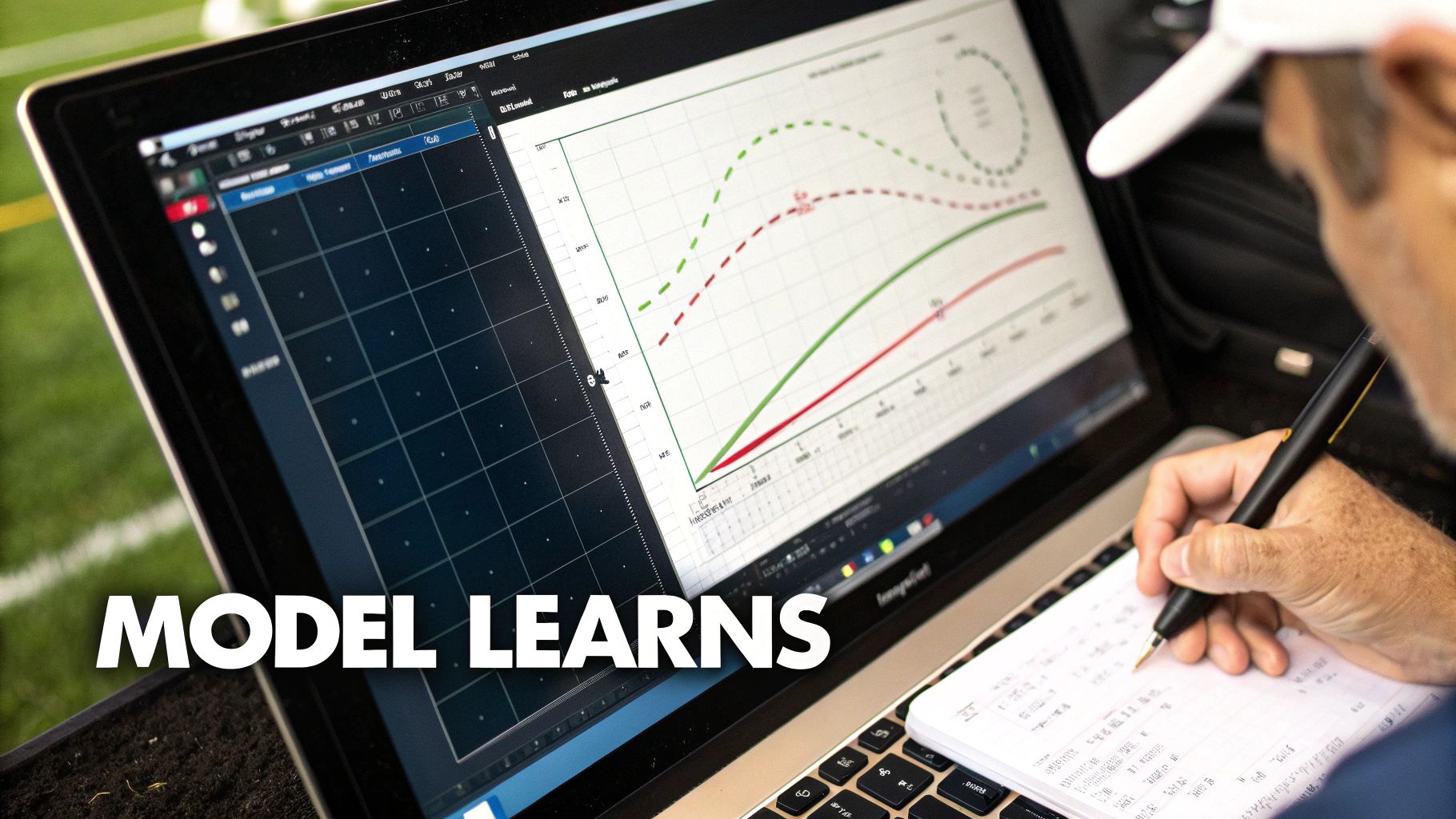
So, you've run your first training command. That single line of code kicked off a storm of calculations, but what was really going on? It's easy to treat this part as a "black box," but getting a feel for the learning process is what separates someone who just runs code from someone who truly understands how to build effective AI.
Think of it like studying for an exam. You tackle a practice question (the data), you give it your best shot (a prediction), and then you check the answer key to see how you did. Based on that feedback, you adjust your approach for the next question. An AI model does the exact same thing, just millions of times faster.
The Role of the Loss Function
At the core of this whole process is something called a loss function. Don't get hung up on the name; it’s really just a "mistake calculator." Its entire job is to measure how far off your model's prediction was from the actual, correct answer.
For instance, if your model predicted a house price of $310,000 but the real price was $300,000, the loss function is what quantifies that $10,000 gap. The model's singular goal during training is to shrink that loss number, getting it as close to zero as humanly possible. This is the engine that drives improvement.
Avoiding the Pitfall of Overfitting
Now, as your model diligently trains, a sneaky problem often pops up: overfitting. This is a massive concept you need to get your head around. Overfitting is what happens when your model gets too good at recognizing the patterns in your training data.
It’s like a student who simply memorizes the answers to a practice exam but fails to grasp the underlying concepts. When faced with a new question they've never seen, they're toast. An overfit model looks brilliant on the data it was trained on but falls apart when it sees fresh, real-world data.
You can usually spot overfitting when your training accuracy is sky-high (like 99%), but your accuracy on a separate test set is noticeably lower.
Luckily, we have a few ways to fight back:
- Feed It More Data: The more diverse examples your model sees, the harder it is for it to just memorize the inputs. It's forced to learn the general rules instead.
- Keep It Simple: Sometimes a less complex model is the answer. A simpler architecture can prevent the model from getting bogged down in the noise and force it to focus on the actual signal.
- Use Regularization: This is a family of techniques that essentially penalize the model for becoming too complex, nudging it toward simpler, more generalizable solutions.
Mastering this balance is key. For a deeper dive into more advanced methods, especially in complex architectures where these techniques are vital, our guide comparing deep learning vs machine learning is a great next step.
The Iterative Nature of Building AI
This all points to a fundamental truth in AI development: it's never a straight line. The work is a constant loop of building, testing, and refining. You train a model, you evaluate its performance, you spot its weaknesses, and you head back to the drawing board.
Maybe the data needs more cleaning. Perhaps you realize you need to engineer a new feature that could be a game-changer. For example, in our housing model, what if we created a "bathrooms per bedroom" feature? That might capture value better than either number alone. Or maybe the algorithm you picked just isn't the right tool for the job. Every single attempt teaches you something valuable.
From My Experience: Your first model is never your last. The real skill isn't in building the first version; it's in the relentless tuning, testing, and trying again. That's where the breakthroughs happen.
This cycle of continuous improvement is the day-to-day reality for any AI practitioner. It's less about a single flash of genius and more about persistent, intelligent iteration. By understanding what's happening under the hood, you develop the intuition to debug, diagnose, and ultimately elevate your models from good to great.
Your Role in a World of AI-Powered Coding
With AI models now writing surprisingly good code, it's natural to wonder: if a machine can program, what’s left for human developers to do? It's a fair question, especially when tools like GitHub Copilot can spit out entire functions based on a simple comment.
But here’s the reality: this shift doesn't make developers obsolete. It just changes the job description. Instead of getting bogged down in writing boilerplate or routine functions, your value moves up the stack. You become the architect, the creative problem-solver, and the final line of defense for quality.
The scale of this transition is hard to overstate. Projections show that in 2025, AI could generate a staggering 41% of all code written worldwide. That's about 256 billion lines of code in a single year. As you can discover more insights about AI-generated code statistics on elitebrains.com, it's clear the industry is pivoting. Developers are spending less time on manual coding and more time on high-level system design and critical review.
From Coder to Conductor
Think of your new role as being the conductor of an orchestra. The AI can play the instruments, but you’re the one who directs the symphony. AI assistants are powerful, but they operate without genuine context. They don't understand your company's business goals, the specific needs of your users, or the ethical guardrails a new feature must adhere to.
That's where your expertise comes in. Your work will increasingly revolve around:
- Creative Problem-Solving: You'll be the one to identify the real problem that needs solving and then break it down into logical pieces an AI can help build.
- System Architecture: Designing the blueprint of an application is a human skill. You'll decide how different services and components talk to each other to create a scalable and maintainable product.
- Critical Code Review: This is huge. You'll spend more time reading, testing, and validating AI-generated code than writing from scratch. Your job is to spot the subtle bugs, security holes, and performance issues an AI will inevitably miss.
Take a look at GitHub Copilot in action. It’s not just suggesting a word or two; it’s proposing entire blocks of code right inside the editor.
This shows how the tool acts more like a collaborative partner. It handles the tedious parts, freeing you up to focus on the more complex, high-impact logic.
The Uniquely Human Skills That Matter Most
While an AI can answer the "how," your real value comes from asking "why" and "what if." The skills that are becoming indispensable are the ones machines simply can't replicate.
Your job will not be taken by AI. It will be taken by a person who knows how to use AI.
This insight nails it. Your ability to ask the right questions, apply deep domain knowledge, and think critically about the big picture is your new superpower. It's on you to ensure the AI's output is not just functional but also secure and responsible. This means staying vigilant about potential biases in the training data and algorithms, a challenge where human oversight is absolutely critical. To get a better handle on these issues, it helps to understand the broader artificial intelligence privacy concerns.
Common Questions About AI Programming
Jumping into AI programming for the first time brings up a ton of questions. It's a massive field, and it’s completely normal to feel a little lost about where to start or what you really need to know. We’ve pulled together some of the most frequent questions we hear from people just starting out to give you some clear, no-nonsense answers.
How Much Math Do I Really Need to Program AI?
This is probably the question I get asked most often, and the answer is way less scary than you might think. While the folks doing groundbreaking AI research are deep in heavy-duty mathematics, you absolutely do not need to be a math wizard to start building AI applications.
Modern libraries like Scikit-learn and TensorFlow are specifically designed to do the heavy lifting—all the complex calculus and linear algebra—for you. For most practical work, a good grasp of high-school-level algebra is genuinely enough to get your foot in the door.
What's more important is building an intuition for the concepts. You need to understand what a loss function is trying to do, not necessarily how to derive its formula from scratch on a whiteboard. You can always go deeper into the math later on as your projects demand it.
My Take: I always tell people to think of it like driving a car. You need to know what the steering wheel and pedals do to get from A to B, but you don’t need to be able to build an internal combustion engine from scratch. Let the tools handle the mechanics.
Can I Learn AI Without a Computer Science Degree?
Yes, one hundred percent. Some of the most creative and effective people I've met in the AI space are self-taught or transitioned from totally different fields like physics or even neuroscience. Today, your ability to learn isn't gated by a formal university program.
The internet is packed with fantastic tutorials, open-source projects you can contribute to, and incredibly supportive online communities. At the end of the day, what really matters to employers and collaborators is what you can build.
- Start small. Don't try to build a self-driving car on your first weekend. Tackle something achievable.
- Build a portfolio on GitHub. This is your new resume. It's a living, breathing showcase of your skills and passion.
- Solve problems you actually care about. This is the secret to staying motivated and truly internalizing what you're learning.
A strong portfolio of real, working projects almost always speaks louder than a piece of paper.
What Is the Difference Between AI, ML, and Deep Learning?
It’s easy to get these terms tangled up, but their relationship is actually pretty simple. The best way to think about them is like a set of Russian nesting dolls.
- Artificial Intelligence (AI): This is the biggest doll, the umbrella term. AI covers any technique that enables a computer to mimic human intelligence in some way, from old-school rule-based game bots to the most advanced reasoning systems.
- Machine Learning (ML): This is the next doll inside. ML is a specific approach to achieving AI. Instead of being explicitly programmed for every task, a machine learning system learns patterns directly from data. Our house price predictor from earlier was a classic ML model.
- Deep Learning (DL): This is the smallest, most specialized doll. It's a subset of machine learning that uses complex, multi-layered "neural networks" to tackle very sophisticated problems like image recognition, language translation, and generating art.
How Long Does It Take to Get a Job in AI?
There's no single magic number here—it really depends on your starting point and how much time you can realistically commit. That said, for someone putting in consistent effort, say 15-20 hours a week, a reasonable timeline to become competitive for a junior role is somewhere in the six-to-twelve-month range.
The most critical factor is getting past the "tutorial phase." The real learning, and what ultimately gets you noticed, happens when you start building your own unique projects from scratch. Find a dataset that fascinates you, come up with a question you want to answer, and use the tools we've discussed to find that answer. That’s the path from learner to practitioner.
At YourAI2Day, we're here to give you the resources and insights you need to make sense of the world of artificial intelligence. Explore our other articles and guides to keep your learning journey moving forward.
